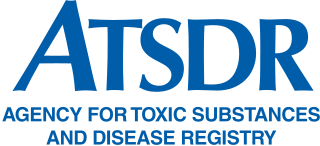Related Research Articles

The Centers for Disease Control and Prevention (CDC) is the national public health agency of the United States. It is a United States federal agency, under the Department of Health and Human Services, and is headquartered in Atlanta, Georgia.

The Agency for Toxic Substances and Disease Registry (ATSDR) is a federal public health agency within the United States Department of Health and Human Services. The agency focuses on minimizing human health risks associated with exposure to hazardous substances. It works closely with other federal, state, and local agencies; tribal governments; local communities; and healthcare providers. Its mission is to "Serve the public through responsive public health actions to promote healthy and safe environments and prevent harmful exposures." ATSDR was created as an advisory, nonregulatory agency by the Superfund legislation and was formally organized in 1985.

Preventive healthcare, or prophylaxis, consists of measures taken for disease prevention. Disease and disability are affected by environmental factors, genetic predisposition, disease agents, and lifestyle choices, and are dynamic processes which begin before individuals realize they are affected. Disease prevention relies on anticipatory actions that can be categorized as primal, primary, secondary, and tertiary prevention.
The National Center for Health Statistics (NCHS) is a principal agency of the U.S. Federal Statistical System, which provides statistical information to guide actions and policies to improve the public health of the American people. NCHS is one of the principal statistical agencies in the federal government.
School violence encompasses physical violence, including student-on-student fighting and corporal punishment; psychological violence, including verbal abuse; sexual violence, including rape and sexual harassment; many forms of bullying, including cyberbullying; and carrying weapons in school. It is widely held to have become a serious problem in recent decades in many countries, especially where weapons such as guns or knives are involved. It includes violence between school students as well as physical attacks by students on school staff.

Suicide prevention is a collection of efforts to reduce the risk of suicide. These efforts may occur at the individual, relationship, community, and society level. Suicide is often preventable.
NORC at the University of Chicago is one of the largest independent social research organizations in the United States. Established in 1941 as the National Opinion Research Center, its corporate headquarters is located in downtown Chicago, with offices in several other locations throughout the United States. Organized as an independent corporation, more than half its board comes from faculty and administration of the University of Chicago, it also jointly staffs some university academic research centers.
Workplace wellness is any workplace health promotion activity or organizational policy designed to support healthy behavior in the workplace and to improve health outcomes. Known as 'corporate wellbeing' outside the US, workplace wellness often comprises activities such as health education, medical screenings, weight management programs, on-site fitness programs or facilities.
The Centers for Disease Control and Prevention, formed in 1946, is the leading national public health institute of the United States. It is a United States federal agency, under the United States Department of Health and Human Services. Its main goal is to protect public health and safety through the control and prevention of disease, injury, and disability in the US and internationally.

Inclusion, in relation to persons with disabilities, is defined as including individuals with disabilities in everyday activities and ensuring they have access to resources and opportunities in ways that are similar to their non-disabled peers. Disability rights advocates define true inclusion as results-oriented, rather than focused merely on encouragement. To this end, communities, businesses, and other groups and organizations are considered inclusive if people with disabilities do not face barriers to participation and have equal access to opportunities and resources.

Field Epidemiology is the application of epidemiologic methods to unexpected health problems when a rapid on-site investigation is necessary for timely intervention. A more expansive definition is: The practice of Epidemiology in the field. Work is done in communities often as a public health service and as part of government or a closely allied institution. Field epidemiology is how epidemics and outbreaks are investigated, and is used to implement measures to protect and improve the health of the public. Field epidemiologists must deal with unexpected, sometimes urgent problems that demand immediate solution. Its methods are designed to answer specific epidemiologic questions in order to plan, implement, and/or evaluate public health interventions. These studies consider the needs of those who will use the results. The task of a field epidemiologist is not complete until the results of a study have been clearly communicated in a timely manner to those who need to know, and an intervention made to improve the health of the people.
The National Health and Nutrition Examination Survey (NHANES) is a survey research program conducted by the National Center for Health Statistics (NCHS) to assess the health and nutritional status of adults and children in the United States, and to track changes over time. The survey combines interviews, physical examinations and laboratory tests.
A health risk assessment is one of the most widely used screening tools in the field of health promotion and is often the first step in multi-component health promotion programs.

The transition from a one-party state to a multi-party democracy significantly strengthened the already cordial U.S. relationship with Malawi. Significant numbers of Malawians study in the United States. The United States has an active Peace Corps program, Centers for Disease Control and Prevention, Department of Health and Human Servicess, and an Agency for International Development (USAID) mission in Malawi. Both countries have a common history and English language, as they were part of the British Empire.
Chronic, non-communicable diseases account for an estimated 80% of total deaths and 70% of disability-adjusted life years (DALYs) lost in China. Cardiovascular diseases, chronic respiratory disease, and cancer are the leading causes of both death and of the burden of disease, and exposure to risk factors is high: more than 300 million men smoke cigarettes and 160 million adults are hypertensive, most of whom are not being treated. An obesity epidemic is imminent, with more than 20% of children aged 7–17 years in big cities now overweight or obese. Rates of death from chronic disease in middle-aged people are higher in China than in some high-income countries.

America's Health Rankings started in 1990 and is the longest-running annual assessment of the nation's health on a state-by-state basis. It is founded on the World Health Organization holistic definition of health, which says health is a state of complete physical, mental, and social well-being and not merely the absence of disease or infirmity. America's Health Rankings is a partnership of the United Health Foundation, and the American Public Health Association.
Sex education in the United States is taught in two main forms: comprehensive sex education and abstinence-only. Comprehensive sex education is also called abstinence-based, abstinence-plus, abstinence-plus-risk-reduction, and sexual risk reduction sex education. This approach covers abstinence as a choice option, but also informs adolescents about human sexuality, age of consent and the availability of contraception and techniques to avoid contraction of sexually transmitted infections.
The PRECEDE–PROCEED model is a cost–benefit evaluation framework proposed in 1974 by Lawrence W. Green that can help health program planners, policy makers and other evaluators, analyze situations and design health programs efficiently. It provides a comprehensive structure for assessing health and quality of life needs, and for designing, implementing and evaluating health promotion and other public health programs to meet those needs. One purpose and guiding principle of the PRECEDE–PROCEED model is to direct initial attention to outcomes, rather than inputs. It guides planners through a process that starts with desired outcomes and then works backwards in the causal chain to identify a mix of strategies for achieving those objectives. A fundamental assumption of the model is the active participation of its intended audience — that is, that the participants ("consumers") will take an active part in defining their own problems, establishing their goals and developing their solutions.
The National Health Interview Survey (NHIS) is an annual, cross-sectional survey intended to provide nationally representative estimates on a wide range of health status and utilization measures among the nonmilitary, noninstitutionalized population of the United States. Each annual data set can be used to examine the disease burden and access to care that individuals and families are currently experiencing in the United States.
Adverse childhood experiences (ACEs) encompass various forms of physical and emotional abuse, neglect, and household dysfunction experienced in childhood. ACEs have been linked to premature death as well as to various health conditions, including those of mental disorders. Resulting toxic stress has also been linked to childhood maltreatment, which is related to a number of neurological changes in the structure of the brain and its function. The Adverse Childhood Experiences Study was the first large scale study to look at the relationship between ten categories of adversity in childhood and health outcomes in adulthood.
References
- ↑ "BRFSS Frequently Asked Questions (FAQs)". Center for Disease Control.